Poland’s defense of coal, which has been a measure of energy independence from Russia, might actually be an asset to the Kremlin’s influence.
WARSAW — When he was Poland’s prime minister, European Council President Donald Tusk called coal “the strategic foundation” of his country’s energy security, and Polish diplomats have acquired a reputation as some of the EU’s toughest negotiators, doing battle in summit after summit to minimize restrictions on its use.
But paradoxically, Poland’s dogged defense of coal, which generates almost 90 percent of its electricity, may now end up benefiting Russia. That is because cheap Russian coal is grabbing a growing share of Poland’s market, while local coal producers bleed red ink thanks to high production costs and very low prices.
“Individual mines can still be saved, but what cannot be saved is the state-owned coal mining sector,” says Jerzy Markowski, a former deputy minister of economy and coal mining executive.
Poland’s coal sector has long been a mainstay of the economy.

























